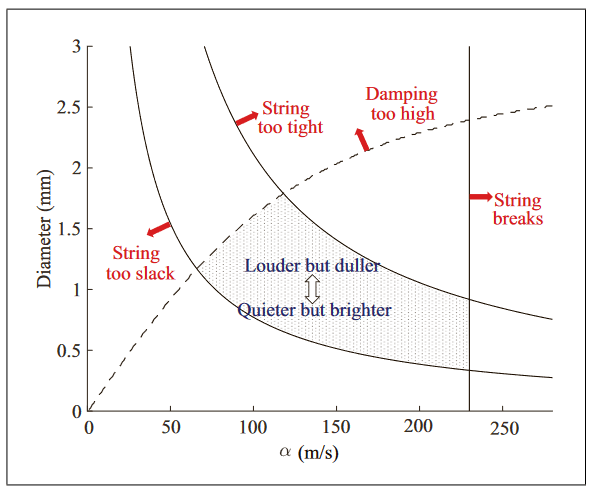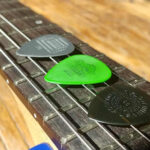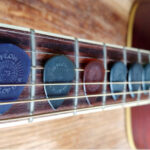Strings mark the starting point of the guitar’s sound and help shape its sonic characteristics.
Making the right choice of string is no easy decision. Each musician has their own personal preferences and every instrument responds in its own way.
This article is not a summary of other website’s string reviews or personal preferences. It is based on scientific research and interviews with experts to explain how string material, gauge, and tension can help shape sound.
With that knowledge, you can look past the marketing and select the type of strings that can support the tone you want.
Table of Contents
How a string’s gauge, material and tension affect brightness and volume
String sets generally come in light, medium and heavy gauges (although there are no standard definitions). It is a key factor that determines string tension, which is the amount of force required to tune the string.
A heavy string will have a greater mass than a light string, and so require more force (string tension) to bring up to pitch. In most cases, this means heavier strings are harder to play, but there are just as important sound implications.
The greater mass of heavier strings creates more vibrational energy – they are louder than lighter strings.
But research by Professor Jim Woodhouse and Nicolas Lynch-Aird has also shown that the trade-off is a less bright sound, as seen in the following design chart for nylon strings. Each string can be plotted on the graph (the x-axis is string frequency x string length).

It shows that a thicker string will tend to be louder but less bright, while a thinner string (with lower tension and impedance) will be quieter but brighter-sounding, according to their research paper.
“I’m not saying the damping threshold always means it’s bad and unmusical but it always has this characteristic lack of twanginess which you can’t get away from,” Professor Woodhouse said. “You can always make less twang by playing; you can’t make more. But it will be different; whether that’s good or bad depends on what you’re trying to do.”
A good example using nylon strings is to play a G note at the 12th fret of the third string and compare its tone to the same note played on the first string at the third fret.
However, there are ways to create both a brighter and louder sound – by changing the string material.
Gut strings are more dense than nylon while fluorocarbon is more dense than both. This greater mass, and the nature of each material, raises the damping threshold for both gut and fluorocarbon.
Gut strings
Gut strings – sometimes called catgut – are hand made from the intestines of animals such as sheep or cows.
All stringed instruments, including the guitar, were strung with animal gut or silk strings until the advent of nylon in the 1940s. Unfortunately, they come with a long list of drawbacks. They are sensitive to temperature and humidity, which makes them difficult to keep in tune, and break easily.
Gut retains some popularity today with guitarists playing antique instruments, who want to replicate the sound of the era. They also remain popular for some other stringed instruments, such as the harp.
Guitarists often claim that gut strings produce a more warm and resonant sound than nylon strings. However, Professor Woodhouse’s study show that the damping threshold that cuts out overtones is higher than nylon strings. It means gut strings actually sound more bright than nylon.
Many harpists still prefer the sound of gut strings over nylon – the research shows why. Harpists use a much higher tension on the longer strings, probably to keep the feel similar across the full range of strings, which brings the damping threshold more into play.
You can read more about gut strings and why they sound different in our article, Gut guitar strings: the temperamental sounds of history.
Nylon strings
The dominant era of gut strings came to a close when DuPont invented nylon in the lead up to World War II. Nylon soon made its way into a wide array of everyday items including toothbrush bristles (1938), women’s stockings (1939) and eventually guitar strings (1944).
The first nylon strings reportedly had a metallic sound but they quickly improved, becoming the de facto choice for guitarists.
Not all nylon strings are made of the same material
Nylon strings may look the same, but there is a wide range of nylon fibers (synthetic polyamide) on the market. Tests also show that the sound of nylon treble strings changes over time.
“It carries on stretching for quite a long time so its properties will change. When your top string has been on for three months, it will be different than when it’s only been on for a week.”
String manufacturers rarely disclose the type of nylon they use but it’s clear they don’t all use the same type. In my experience, typical D’Addario nylon trebles feel nothing like a standard Savarez set of trebles.
What’s more, some string manufacturers have been known to use different types of nylon within one set.
For example, back in 1991, French string manufacturer Savarez told acoustician Antoine Chaigne that its metal over-wrapped bass strings have a nylon 6-6 core but its treble strings use monofile of nylon 6-10 or 6-12. (Different types of nylon polymers are described by a numbering system, which indicates the number of carbon atoms in the monomer chains.)
Prior to that, a different type of nylon was commonly used by string manufacturers – nylon 6 – but eventually fell from fashion due to its lack of brightness, according to Chaigne.
Black nylon strings
These differences between nylons don’t take into account a more obvious difference: color. Most nylon strings are clear but some sets are also colored black and red. They are said to sound brighter, which is why these sets are often aimed at flamenco and folk guitarists.
Scientific tests have confirmed that colored dye itself is unlikely to create a brighter sounding string.
However, colored sets may be made from different polymer or manufactured differently than clear nylon, which may affect its sound. The only way to tell is to experiment with different sets.
You can read more in our article, Black nylon guitar strings versus clear: is there a difference?
Ball-end nylon strings
Ball-end nylon strings are aimed at folk artists or guitarists shifting from steel-string acoustic or electric guitars.
The benefit is largely psychological rather than practical. Learning to string a classical guitar is a simple skill, like learning to tie your shoes.
Fluorocarbon strings can present more of a challenge. The first time I tried a set, the first string went flying off, something which never happens with nylon. There could be a combination of reasons, such as less friction or that the strings are often thinner because the material is so dense.
A common solution is to slightly melt one end of the treble strings with a lighter or a match. This creates a pseudo melted ball-end that provides some extra grip once the strings are tied off. Another solution is to tie a simple overhand knot or figure-of-eight knot, which acts as a stop.
Fluorocarbon strings: brighter, harder
Fluorocarbon treble strings are made of a polymer called polyvinylidine fluoride (PVDF). This material is a dense material that creates a brighter sound, which is closer to the sound of gut strings but without the same price tag or tuning issues.
Like gut strings, tests have shown fluorocarbon strings damping threshold is higher than for nylon strings. However, these overtones do create a slightly different sound than gut strings.
“Every individual string gets closer to this damping cutoff as you play up the frets,” Professor Woodhouse said.
This issue is most pronounced on the G string of the guitar. The reason? It is the thickest of the treble strings, which creates more string stiffness. This naturally interferes with the vibration of the string, creating greater inharmonicity (or overtones that are not pleasing to the ear) and reducing sustain.
The nature of fluorocarbon, which is denser than nylon, provides one potential answer. Replacing the nylon G string with a brighter sounding fluorocarbon string can create more evenness of tone across the full treble string range.
Fluorocarbon strings greater density means they also tend to project sound more powerfully than nylon strings. But this greater density can also make vibrato harder, and some find the strings harder to fret.
See if you can hear the difference in the video below.
String maintenance: Why do bass strings go dead?
Monofilament strings, such as nylon, may change with time but they don’t suffer from deadness. The wrapped bass strings are a different matter.
Guitarists are forced to change their strings regularly because the sound quality deteriorates with time. Sometimes it can take just days for the initial brilliance or brightness to be replaced by dullness.
Every musical note consists of a fundamental frequency (or lowest note) and a range of overtones. Old metal strings tend to produce weaker overtones at frequencies between 2.5 kHz and 10 kHz (above the 15th or 20th harmonic) compared to new strings, according to a University of Iowa study.
Both the amplitude and decay times of these higher overtones drops off quickly, creating a dull sound.
The researchers were also able to replicate old strings by rubbing fine potter’s clay into new wound metal strings, suggesting “foreign matter between the turns of wound strings is at least a principal cause, and probably the main cause, of deadness.”

The old-fashioned advice for thrifty guitarists wanting to cure dead strings was to boil them in vinegar or wash them in water. The study found it did, in fact, improve the sound. Removing and re-installing strings also helped because it loosened dirt and grime.
This research shows why it’s important to have clean hands before playing and wipe down strings.
It has also become more common for string manufacturers to offer coated strings that offer extra protection against the corrosive effects of sweat and grime. For example, the D’Addario EXP Coated Classical Guitar Strings range applies a micro-fine EXP coating to its silverplated copper wrap wire before winding.
Stopping treble strings from breaking
Gut and fluorocarbon strings have a lower breaking threshold than nylon. Unfortunately, that threshold is commonly reached on the first string when it is tuned to a standard E.
“So you don’t use fluorocarbon or gut for the really tight strings,” Professor Woodhouse said.
While harpists tend to prefer the sound of gut strings, “they usually use nylon on their shortest, highest strings because they have such a short lifespan anyway. They’re just a little bit longer-lived and cheaper when you’re forever replacing them.”
- STANDARD CLASSICAL TONE – Pro -Arte’ Nylon strings offer the standard classical guitar tone many players hold dear.
- RESPONSIVE PLAYABILITY & WARM TONE – Utilizing our multi-filament nylon core basses and clear nylon trebles, Pro-Arte’ Nylon strings provide…
- TIE ENDS – This set features tie-ends, nylon monofilament material, and silver-plated copper wrap wire.
- COATED CLASSICAL STRINGS -XT Classical strings feature an advanced corrosion resistance treatment on every wound string in the set, preserving the…
- PURE CLASSICAL TONE – Utilizing our proprietary composite basses and precisely intonated Pro-Arté nylon trebles, XT Classical strings provide a…
- TIE ENDS – This set features tie-ends, nylon monofilament material, and silver-plated copper wrap wire.
- Nylon guitar strings for classical guitars
- Basses are wound with 80/20 Bronze for brighter tone. Trebles are black nylon
- Medium tension











